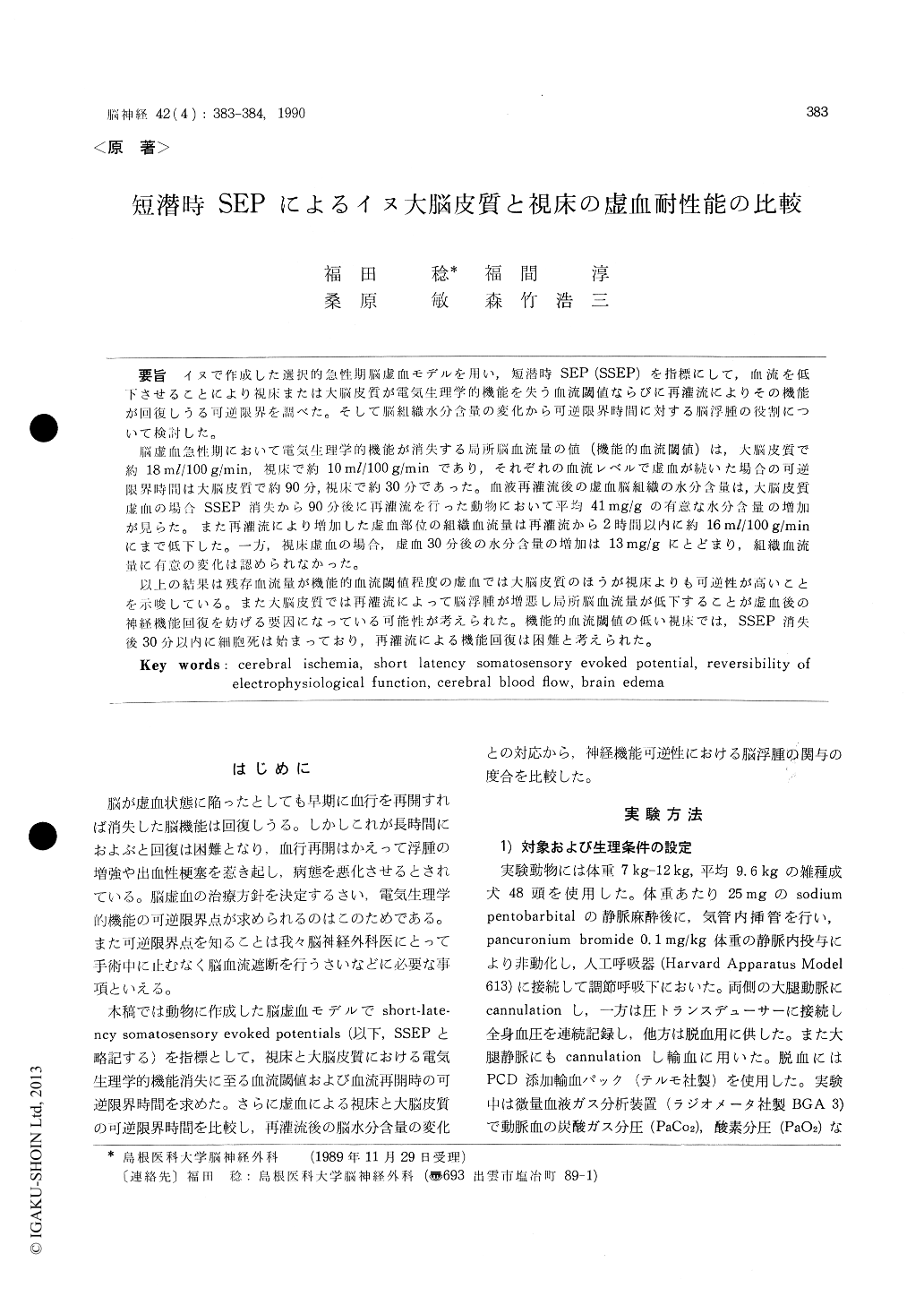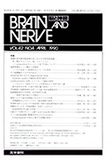Japanese
English
- 有料閲覧
- Abstract 文献概要
- 1ページ目 Look Inside
イヌで作成した選択的急性期脳虚血モデルを用い,短潜時SEP(SSEP)を指標にして,血流を低下させることにより視床または大脳皮質が電気生理学的機能を失う血流閾値ならびに再灌流によりその機能が回復しうる可逆限界を調べた。そして脳組織水分含量の変化から可逆限界時間に対する脳浮腫の役割にっいて検討した。
脳虚血急性期において電気生理学的機能が消失する局所脳血流量の値(機能的血流閾値)は,大脳皮質で約18ml/100g/min,視床で約10ml/100g/minであり,それぞれの血流レベルで虚血が続いた場合の可逆限界時間は大脳皮質で約90分,視床で約30分であった。血液再灌流後の虚血脳組織の水分含量は,大脳皮質虚血の場合SSEP消失から90分後に再灌流を行った動物において平均41mg/gの有意な水分含量の増加が見らた。また再灌流により増加した虚血部位の組織血流量は再灌流から2時間以内に約16ml/100g/minにまで低下した。一方,視床虚血の場合,虚血30分後の水分含量の増加は13mg/gにとどまり,組織血流量に有意の変化は認められなかった。
以上の結果は残存血流冠が機能的血流閾値程度の虚血では大脳皮質のほうが視床よりも可逆性が高いことを示唆している。また大脳皮質では再灌流によって脳浮腫が増悪し局所脳血流鍛が低下することが虚血後の神経機能回復を妨げる要因になっている可能性が考えられた。機能的血流閾値の低い視床では,SSEP消失後30分以内に細胞死は始まっており,再灌流による機能回復は困難と考えられた。
Using cerebral cortical and thalamic ischemia models produced in mongrel dogs, the reversibi-lity of short-latency somatosensory-evoked poten-tials (SSEPs) and the effects of ischemic brain ede-ma on reversibility were compared. The mean systemic blood pressure (MSBP) of animals was reduced by exsanguination until cortical SSEPs disappeared, and was held constant at that level. The MSBP was recovered by autogenous blood transfusion at 30 minutes (subgroup A), 60 minutes (subgroup B) and 90 minutes (subgroup C) after SSEP disappearance in the cortical ischemia group ; and at 15 minutes (subgroup D) and 30 minutes(subgroup E) after SSEP disappearance in the thalamic ischemia group. Local cerebral blood flows (lCBF) were measured and SSEPs were monitored serially up to 2 hours after blood transfusion. At the end of measurement, the leakage of Evans blue was evaluated and brain tissue water content was measured.
Cortical SSEPs disappeared when lCBF in the right cerebral cortex, measured by hydrogen cle-arance method decreased to 18.4±5.4 ml/100 gl min (mean ±SD) and neuronal transmission fa-ilure in thalamus occurred when thalamic blood flow decreased to 10.0 ± 3.3 ml/100 g/min. After blood transfusion, SSEP reappeared in all 12 ani-mals in subgroup A, but did not appear in 2 of 9 animals in subgroup B and in all of 7 animals in subgroup C. In the thalamic ischemia group, SSEP recovery was seen in 9 of 10 animals in subgroup D and 1 of 10 animals in subgroup E. lCBFs of ischemic regions increased to more than the pre-exsanguination level in all animals, and was main-tained the pre-exsanguination level or a high level except the animals in subgroup C. In subgroup C, which showed no SSEP recovery, lCBF in the ischemic areas decreased rapidly after a temporary increase. Evans blue leakage in ischemic regions was seen in 4 of 7 animals in subgroup A, 2 of 5 animals in subgroup B and both animals of subg-roup C, but it was seen in only one animal in tha-lamic groups. Water contents of ischemic regions in subgroups A, B and C water contents increa-sed 16, 21 and 41 mg/g respectively in comparison with non-ischemic side. In the thalamus, there was no significant increase in both subgroups.
In acute ischemia, if ICBF was maintained in functional threshold level, the electrophysiological function of the cerebral cortex was more reversible than that of thalamus. After reperfusion, the reduc-tion of lCBF due to severe edema was thought to be responsible for the poor SSEPs recovery in the cortical ischemia group. The functional thresh-old in the thalamus may be closer to that of the cell membrane. Accordingly, cellular damage is considered to start prior to interruption of blood flow by brain edema and within 30 minutes after the disappearance of SSEPs.

Copyright © 1990, Igaku-Shoin Ltd. All rights reserved.


